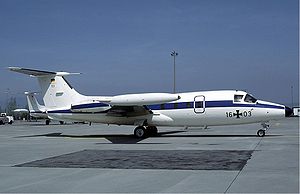- Hamburger Flugzeugbau HFB-320 Hansa Jet
-
Hansa Jet Hamburger Flugzeugbau HFB-320 Hansa Jet of the Luftwaffe at Basle Airport Role Business jet Manufacturer Hamburger Flugzeugbau First flight 21 April 1964 Retired 24 June 1994 Number built 47[1] The Hamburger Flugzeugbau HFB-320 Hansa Jet is an all-metal, twin-engine, 10-seat business jet built by German aircraft manufacturer Hamburger Flugzeugbau between 1964 and 1973.
The most notable feature of the aircraft is its forward-swept wing, which is mid-mounted in the fuselage. This arrangement allows the wing spar to pass through the fuselage behind the passenger cabin without decreasing cabin volume. As of 2011[update], it remains the only civilian jet ever to use a forward-swept wing.
Contents
Development
The prototype first flew on April 21, 1964 and was followed by a second prototype on October 19 of the same year.[2] On May 12, 1965, the first prototype was lost in an accident caused by a design issue with the T-tail. Hamburger Flugzeugbau's chief test pilot perished in the crash. As a result of the accident, modifications were made to improve the aircraft's stall performance, including a stick pusher on production models. Assembly of the first ten production aircraft began in May 1965, with the first flying on February 2, 1966 and two others shortly thereafter. Certification was achieved in 1967, and General Air of Hamburg took first customer delivery in March 1968.
The Luftwaffe had ordered 13 HFB-320s in 1963.[citation needed] As part of the evaluation of the type, two pre-production aircraft were delivered to the Est61 test wing at Oberpfaffenhoffen in 1966.[1][3] This resulted in six aircraft being ordered for VIP use by the Luftwaffe.[1] Production deliveries for use as VIP transports commenced in 1969.
A further eight Hansa jets were purchased by the Luftwaffe for ECM training, these being delivered between August 1976 and April 1982. The Luftwaffe replaced its VIP Hansas by Canadair Challengers in 1987, but the ECM aircraft remained in service until 1994.[4]
Increased competition from newer executive jet models and a comparatively poor safety record led to dwindling orders, with production ceasing in 1973. The Aviation Safety Network lists a total of nine accidents (six fatal) for the type,[5] an astounding 20 percent hull-loss rate, but only the crash of the prototype was directly attributable to the aircraft's design. Pilot error was blamed in a majority of the accidents.
Civilian Operators
- (USA)
- Midwest Air Charter
Military operators
Specifications (HFB 320)
Data from [6]
General characteristics
- Crew: Two
- Capacity: 7, 11 or 15 passenger configurations
- Length: 16.61 m (54 ft 6 in)
- Wingspan: 14.48 m (47 ft 6 in)
- Height: 4.92 m (16 ft 2 in)
- Wing area: 30.14 m² (324.4 ft²)
- Empty weight: 5,511 kg (12,125 lb)
- Max takeoff weight: 9,218 kg (20,280 lb)
- Powerplant: 2 × General Electric CJ610-5 turbojet engines, 13.15 kN (2,950 lbf) each
Performance
- Cruise speed: 825 km/h (445 knots, 513 mph)
- Range: 2,413 km (1,303 nm, 1,500 mi)
- Service ceiling: 11,433 m (37,500 ft)
- Rate of climb: 21.6 m/s (4,250 ft/min)
See also
- Aircraft of comparable role, configuration and era
- Lear Jet 25
- Related lists
References
- Sloot, Emiel. "Hansa Jet Retirement". Air International, October 1994, Vol 47 No 4. pp. 234–235. ISSN 0306-5634.
- Taylor, John W. R.. Jane's All The World's Aircraft 1965–66. London: Sampson Low, Marston & Company, 1965.
Blohm & Voss/Hamburger Flugzeugbau aircraft Ha / BV HFB HFB-314 • HFB-320
Lists relating to aviation General Aircraft (manufacturers) · Aircraft engines (manufacturers) · Airlines (defunct) · Airports · Civil authorities · Museums · Registration prefixes · Rotorcraft (manufacturers) · TimelineMilitary Accidents/incidents Records Categories:- Blohm & Voss aircraft
- Forward-swept wing aircraft
- German business aircraft 1960–1969
- German military utility aircraft 1960–1969
Wikimedia Foundation. 2010.

